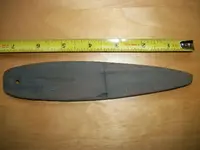You are using an out of date browser. It may not display this or other websites correctly.
You should upgrade or use an alternative browser.
You should upgrade or use an alternative browser.
found this in 2 pieces, anyone know why so huge?
- Thread starter flintmel
- Start date
Gunrunner61
Silver Member
- Joined
- Jan 12, 2011
- Messages
- 2,963
- Reaction score
- 458
- Golden Thread
- 0
- Location
- Dalton,Ga.
- Detector(s) used
- Whites MXT, E Trac, Garrett Pro Pinpointer
- Primary Interest:
- All Treasure Hunting
some type of Shaman's Gorget or Medicine pendent...JMHO....HH
Charl
Silver Member
- Joined
- Jan 19, 2012
- Messages
- 3,076
- Reaction score
- 4,772
- Golden Thread
- 0
- Location
- Rhode Island
- Primary Interest:
- Relic Hunting
Mel, your piece is the exact size and shape of a perforated whetstone illustrated in Curtis Hoffman's "A Handbook of Indian Artifacts from Southern New England"(1991, Ma. Archaeological Society, p. 71). When these whetstones are perforated, they are countersunk pecked from both sides, followed by drilling. The materials most often used are argillite(slate), schist, and sandstone. So your piece may be a perforated whetstone, which are usually in the 6-8" length range. If used as a whetstone, it would show "wear from long even lengthwise strokes of rubbing. Because of this, and the narrow proportions of this honing stone, it is thought to have been used in grinding the blades of gouges and other woodcutting implements"(Hoffman, p. 71) I cannot rule out very large pendant, but the size, shape, and countersunk perforation suggests a whetstone.
Last edited:
flintmel
Sr. Member
- #7
Thread Owner
Response to Charl
Charl, have seen a couple "whetstones" generally thick but well made otherwise, this piece is long and slender and of a material desirable for pendants or atlatl's not for honing
Mel, your piece is the exact size and shape of a perforated whetstone illustrated in Curtis Hoffman's "A Handbook of Indian Artifacts from Southern New England"(1991, Ma. Archaeological Society, p. 71). When these whetstones are perforated, they are countersunk pecked from both sides, followed by drilling. The materials most often used are argillite(slate), schist, and sandstone. So your piece may be a perforated whetstone, which are usually in the 6-8" length range. If used as a whetstone, it would show "wear from long even lengthwise strokes of rubbing. Because of this, and the narrow proportions of this honing stone, it is thought to have been used in grinding the blades of gouges and other woodcutting implements"(Hoffman, p. 71) I cannot rule out very large pendant, but the size, shape, and countersunk perforation suggests a whetstone.
Charl, have seen a couple "whetstones" generally thick but well made otherwise, this piece is long and slender and of a material desirable for pendants or atlatl's not for honing
catherine1
Bronze Member
- Joined
- Jun 25, 2010
- Messages
- 1,814
- Reaction score
- 1,078
- Golden Thread
- 0
- Primary Interest:
- All Treasure Hunting
Nice artiface find. I never find anything that large. Thanks for showing your finds!
Charl
Silver Member
- Joined
- Jan 19, 2012
- Messages
- 3,076
- Reaction score
- 4,772
- Golden Thread
- 0
- Location
- Rhode Island
- Primary Interest:
- Relic Hunting
Charl, have seen a couple "whetstones" generally thick but well made otherwise, this piece is long and slender and of a material desirable for pendants or atlatl's not for honing
Works for me, Mel. Heck of a find.
PrimitiveOne
Sr. Member
- Joined
- Mar 30, 2010
- Messages
- 251
- Reaction score
- 10
- Golden Thread
- 0
- Location
- Pittsburgh, PA
- Detector(s) used
- Eyeballs 2
- Primary Interest:
- Other
Just a thought-What would be sharpened with this stone...Primitive Americans used stone and not metal. There would be no practical use for sharpening in this method..JMO
Similar threads
- Replies
- 12
- Views
- 954
- Replies
- 25
- Views
- 1K
Users who are viewing this thread
Total: 1 (members: 0, guests: 1)




